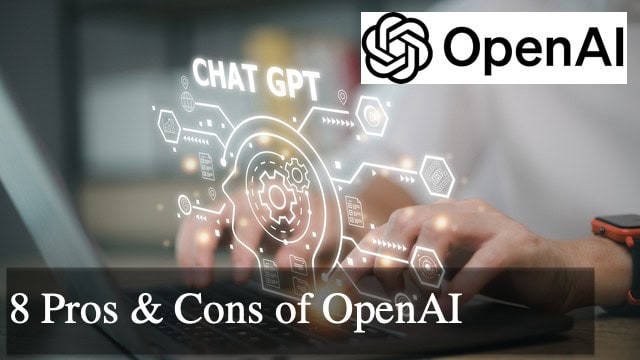
As artificial intelligence (AI) continues to evolve, its applications across various domains are expanding rapidly. OpenAI, one of the most advanced AI platforms available, is making significant inroads into app development. While many enterprises are eager to leverage OpenAI’s capabilities, it is crucial to understand the advantages and disadvantages of using this technology. This comprehensive article synthesizes insights from three authoritative sources to provide a balanced view.
What is OpenAI?
Founded in 2015, OpenAI is an AI research organization focused on developing powerful and beneficial technologies for humanity. It aims to create a world where AI-driven technologies are used ethically and transparently. OpenAI’s portfolio includes a range of advanced models, such as GPT-3, GPT-4, DALL-E, and CLIP, which have applications in natural language processing, robotics, machine learning, and computer vision. These models are used in various applications, including chatbots, virtual assistants, content creation, and image recognition.
Importance of OpenAI in App Development
Integrating OpenAI’s API into apps can offer users advanced AI capabilities, enhancing scalability, efficiency, and productivity. OpenAI’s open and collaborative nature fosters innovation and digital transformation, allowing developers to share and collaborate on their tasks. This collaborative aspect is crucial for pushing the boundaries of what apps can achieve.
Top 8 Pros or Advantages of Using OpenAI in App Development

OpenAI has revolutionized app development by offering powerful tools and models that enhance efficiency, speed, and user experience. By integrating OpenAI, developers can automate repetitive tasks, streamline operations, and leverage advanced analytics for data-driven decision-making. The platform also improves app security, personalization, and predictive capabilities, providing a competitive edge. With these advantages, OpenAI empowers developers to create innovative, scalable, and highly efficient applications that meet modern user demands and drive business growth.
1. Increased Speed and Reduced Development Time
OpenAI can automate various tasks, significantly speeding up the app development process. For instance, OpenAI assists in automating app testing by generating test cases and scripts, which reduces both the development time and cost. Its pre-trained models can be fine-tuned for specific tasks, such as natural language processing (NLP), image generation, and optimization problems, further enhancing development efficiency.
Example: A healthcare technology firm specializing in Healthcare AI development services integrated OpenAI’s models to accelerate their patient engagement platform. By leveraging GPT-4, they automated the generation of personalized health assessments, appointment reminders, and symptom triage suggestions. This reduced development time by 40%, while improving the relevance and accuracy of patient communications, enhancing both efficiency and patient satisfaction.
2. Streamlined Operations
OpenAI’s pre-trained models and machine learning algorithms can automate repetitive tasks such as image recognition, text summarization, and sentiment analysis. For example, GPT-3, an NLP model, can automate customer queries and email responses, freeing up valuable time for developers to focus on more complex issues.
Example: Grammarly uses OpenAI’s GPT-3 to power its writing assistant features. GPT-3 helps automate the tasks of grammar checking, text summarization, and providing style suggestions, streamlining the writing and editing process for users.
3. Improved Customer Experience
By using machine learning algorithms, OpenAI helps developers understand user behavior, preferences, and needs, enabling the creation of highly personalized user experiences. Predictive analytics can forecast user actions, optimize ad targeting, and reduce churn rates, ultimately leading to higher user satisfaction and engagement.
Example: Healthcare AI development services utilize OpenAI’s models to create personalized patient care apps. These apps analyze user health data and preferences to deliver tailored wellness plans and reminders, enhancing patient engagement and satisfaction.
4. Advanced Analytics
OpenAI allows businesses to analyze large datasets and extract meaningful insights, helping developers identify areas for improvement and make data-driven decisions. This capability is particularly useful for enhancing app functionality and performance based on user behavior analysis.
Example: Shopify uses OpenAI’s analytics capabilities to help merchants understand customer behavior and sales patterns. By analyzing vast data, Shopify can provide actionable insights that help merchants optimize their stores and marketing strategies.
5. Enhanced Security
OpenAI’s machine learning models can detect potential security threats, such as malware and unauthorized access, helping safeguard applications. Features like biometric authentication and secure data encryption add additional layers of security, ensuring that sensitive information remains protected.
Example: PayPal employs OpenAI’s machine learning models to detect and prevent fraudulent activities. These models analyze transaction patterns in real-time, identifying potential threats and securing users’ financial data through advanced encryption and authentication methods.
6. Efficiency and Error Reduction
OpenAI can automate code debugging and provide immediate explanations and suggestions for fixing errors, increasing overall development efficiency. OpenAI models can provide accurate and faster diagnoses in fields like medical diagnosis, reducing errors caused by human oversight.
Example: IBM Watson Health utilizes OpenAI models to assist in medical diagnosis. By analyzing medical data and providing accurate diagnostics, Watson Health reduces the likelihood of human error, improves efficiency in clinical settings, and enhances patient care.
7. Easy Integration of AI Features
OpenAI offers various tools and services that can be easily integrated into apps, such as GPT-3 for text generation and DALL-E for image generation. APIs and SDKs for popular programming languages facilitate seamless integration, enabling developers to incorporate advanced AI capabilities without building models from scratch.
Example: Replika, an AI chatbot app, uses OpenAI’s GPT-3 API to create lifelike conversational experiences. Developers can easily integrate GPT-3’s capabilities into the app, allowing it to provide meaningful and personalized user interactions.
8. Scalability and Collaboration
OpenAI’s scalable design allows developers to efficiently handle large volumes of data and requests. Its collaborative API fosters innovation by allowing developers to share their work and build upon each other’s efforts, accelerating the development of advanced AI-driven applications.
Example: Microsoft Teams integrates OpenAI’s models to enhance its collaboration features. By incorporating AI-driven functionalities such as automated meeting transcriptions and intelligent replies, Teams improves productivity and efficiently handles large volumes of user interactions, making it scalable for enterprise use.
Top 8 Cons or Disadvantages of Using OpenAI in App Development

While OpenAI offers numerous advantages in app development, it is also essential to consider the potential drawbacks. Integrating advanced AI models comes with its own set of challenges, including increased costs, integration complexities, data privacy concerns, and limited transparency. Understanding these cons is crucial for businesses and developers to make informed decisions about leveraging OpenAI for their app development projects, ensuring a balanced approach that maximizes benefits while mitigating risks.
1. Increased Cost
One of the primary disadvantages of using OpenAI is the cost associated with its integration and maintenance. Running OpenAI models requires significant computational resources, which can be expensive for many users. Businesses must be prepared to invest in these resources to leverage OpenAI’s full potential.
Example: Netflix leverages OpenAI’s models for content recommendation and personalization. The significant computational resources required for these tasks can lead to high operational costs, making it a substantial investment for the company to maintain these advanced AI features.
2. Integration Challenges
Integrating OpenAI models can be complex and time-consuming, especially for developers unfamiliar with AI technologies. Model size, complexity, latency, and responsiveness can pose significant challenges. Additionally, usage restrictions and licensing agreements may limit the models’ flexibility and specific use cases.
Example: Airbnb faced integration challenges when incorporating OpenAI’s models to enhance their customer support chatbots. The complexity and size of the models required extensive resources and technical expertise, complicating the integration process and extending development timelines.
3. Data Privacy and Security Concerns
OpenAI models are typically trained on large datasets that may include sensitive information. If handled improperly, transmitting this data over the Internet can pose significant security risks. Businesses must implement secure protocols, encrypt data in transit, and perform regular security audits to mitigate these risks.
Example: Facebook encountered data privacy concerns using AI models to analyze user interactions and personalize feeds. The vast amounts of sensitive data processed by these models raised issues regarding user privacy and the potential for data breaches.
4. Lack of Transparency
The complexity of OpenAI models can make it difficult for developers to understand how they process data and make decisions. This lack of transparency can lead to interpretability, safety, and privacy concerns. As a private company, OpenAI may not disclose all details of its technology, further complicating transparency issues.
Example: Amazon uses OpenAI’s models in its recommendation systems. However, the lack of transparency in how these AI models make decisions can lead to trust issues among users, who may find it difficult to understand why certain products are being recommended to them.
5. Possibility of Erroneous Predictions
Despite its advanced capabilities, OpenAI can make erroneous predictions due to biases in the training data or inherent limitations in the models. These inaccuracies can lead to incorrect and potentially harmful outcomes, necessitating human oversight and intervention to correct errors.
Example: Microsoft’s Tay chatbot, an AI model released on Twitter, made erroneous and offensive predictions due to being trained on biased data from user interactions. This highlighted the risks of AI models producing inaccurate or harmful outputs if not properly monitored and controlled.
6. Dependency and Flexibility
Relying heavily on OpenAI for app development can create dependencies that may pose risks if OpenAI changes its policies and licensing terms or discontinues support. Additionally, OpenAI models may not be adaptable to new or evolving requirements, limiting the flexibility of their applications.
Example: Slack relies heavily on OpenAI models to automate customer support and other features. Changes in OpenAI’s policy or licensing terms could force Slack to significantly adjust its app, potentially disrupting services and increasing operational complexity.
7. Limited Interpretability
Understanding the underlying mechanisms of OpenAI models can be challenging for developers and end-users. This limited interpretability can hinder the ability to explain app functionality and decision-making processes, potentially affecting user trust and adoption.
Example: Zillow uses OpenAI models for property value estimation. The complexity of these models makes it challenging for developers to interpret and explain the AI’s decision-making process, which can be problematic when users need transparency about how property values are determined.
8. Complexity for Developers
Working with OpenAI models requires specialized skills and knowledge in AI development, training, and testing. This complexity can be a barrier for entry-level developers and even experienced professionals, making it challenging to leverage OpenAI’s capabilities fully.
Example: A small startup trying to implement OpenAI’s GPT-3 for its customer service chatbot struggled with the complexity of training and fine-tuning the model. The specialized knowledge required for developing, training, and testing the AI posed significant hurdles, especially for a team with limited AI expertise.
Conclusion
OpenAI offers numerous benefits for app development, including increased speed, improved efficiency, enhanced security, and advanced analytics. However, it also presents significant challenges, such as increased costs, integration complexities, data privacy concerns, and limited transparency.
Businesses must consider these pros and cons before integrating OpenAI into their app development projects. Consulting with an expert or a reputable custom software development company can help navigate these challenges and maximize OpenAI’s potential for creating robust, scalable, and innovative applications.
Suggested articles:
- Top 10 Cons & Disadvantages of Artificial Intelligence (AI)
- Top 10 Cons & Disadvantages of ChatGPT
- Top 10 Cons & Disadvantages of Microsoft Copilot
Daniel Raymond, a project manager with over 20 years of experience, is the former CEO of a successful software company called Websystems. With a strong background in managing complex projects, he applied his expertise to develop AceProject.com and Bridge24.com, innovative project management tools designed to streamline processes and improve productivity. Throughout his career, Daniel has consistently demonstrated a commitment to excellence and a passion for empowering teams to achieve their goals.